Calcined Diatomaceous Earth (DE) for Gritty Mix - Evaluations
Thank you to all who've previously posted their experiences with calcined diatomaceous earth. That info made me aware of the need to evaluate the stuff before entrusting plants to it, the primary issue being inconsistent or poor stability/durability - resulting in root smothering sludge in pots and containers.
My intention for this thread is not to advocate for calcined DE as "better" than any other aggregate, but to evaluate which DE products are well suited to our horticultural purposes.
The properties we evaluate in calcined DE include stability/durability during use and recycling, aeration or appropriate screen size range/average, percentage of waste, water retention, Cation Exchange Capacity (cec) otherwise known as nutrient holding capacity, pH effect.
We evaluate these same properties in other components, inorganic or organic, so comparisons are inevitable, and can be useful, but this thread really is intended primarily, as a means to vet various calcined DE products against each other. We can readily test for ourselves: Subjective hardness, runoff pH, aeration properties, waste factors. For most of us, evaluation of cec, water holding and Plant Available Water, is limited to info provided by the product vendors.
Subjective Hardness Test Protocol -
Screen aggregate to produce a pint of good test sample. Wash/drain/rinse with water. Repeat rinse till rinse water is fairly clear. Put in clean quart polypropylene food container, fill to cover with chlorine-free tap water (filtered) to help dilute/dissipate chlorine in the aggregate from the cleaning water, to avoid/reduce oxidation reactions. Soak for two days, keeping aggregate submerged.
After two days, test subjective hardness, using forefinger and thumb, and forefinger and thumbnail, on individual grains to estimate hardness on scale of 1 - 3, and percentages of sample in each hardness level.
Hardness 1: Grain easily smashes, when pinched between finger and thumb; breaks or splits between thumbnail and finger with gentle to moderate pressure.
Hardness 2: Grain splits or breaks between thumbnail and finger with greater than moderate pressure.
Hardness 3: Grain splits between thumbnail and finger with hard pressure, or not at all.
Test until you feel you have a good sense of the material. Perhaps 1/8 cup.
Runoff pH Test Protocol -
When finished with the subjective hardness testing, drain the remaining untested sample, keeping it in the quart polypropylene food container, and rinse with clear, chlorine-free (filtered) water, this time until rinse water runs clear. Loosely drain. Separately, draw some of the source chlorine-free water you used to rinse the aggregate (NOT the used water), and test the pH. This is your baseline. The idea is, this is the water you'll be using to water your plants, and you're going to find out this aggregate's pH effect on your local water.
You will be allowing some water to stand in the aggregate, below the surface, about 1/4 to 1/3 of the height of the aggregate is fine. If your environment is really dry, leave a little more water in the container. Let the sample stand, uncovered, for two days, out of sunlight, at ambient temperature.
After two days, drain some of the water into a clean test cylinder or test tube, and test the pH. This is the runoff pH.
Comments (20)
lunarsolarpower
Original Author9 years agolast modified: 9 years agoUsing the protocols above, I evaluated & compared Axis Regular, and Napa Floor Dry #8822. Axis is engineered as a soil amendment.
My tap water was pH 8.3. Tested with General Hydroponics wide spectrum pH Test Indicator.
My screen was a low quality affair, with variations in the mesh, 10 wires per inch. My grit is a bit coarse, as you will see, due to the mesh irregularities.
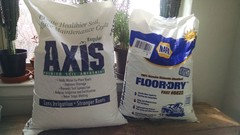
Axis left, Napa right.
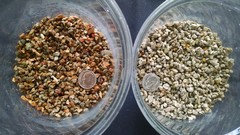
- Napa Floor Dry #8822 -
Not good. Rather uniformly pale gray, soft, higher pH.
Subjective Hardness Test:
100% Hardness 1 (very soft)
Runoff pH Test: About 7.0
Screened waste: Same as Turface, about 40%
CEC: No info
-Axis Regular -
Variety of colors in the mix, the light gray bits identical to Napa, and just as soft, but not predominant. Overall much harder product. Generally, the deeper/darker the color, the harder the particle. Axis rep said the soft fraction I found isn't right, and said he would initiate a quality review to correct the situation.
When I expressed my opinion that clay simply calcines harder than diatomaceous earth, he said that wasn't necessarily the case, and cited examples of industry experience. Sounded good, but fact remains that 75% of my test sample was significantly more friable (soft) than Turface calcined clay.
Nutrient holding, in terms of cec, is generally inconsistent, or low, per the Axis rep. He suggested blending in their crushed basalt, cec 140, to achieve a good and stable cec value when using calcined DE generally. He says the issue is due to the moisture of the incoming raw material lots, which determines the firing temperature required to calcine the DE. The cec for DE is determined by the firing temperature.
My concerns: Is the hardness 2 portion of the product durable enough to resist breaking down during use; will it hold up to processing for reuse; will it remain durable during reuse? I suspect the stuff is fine for a year or so in a pot, but that it will fall apart when cleaning it for reuse, especially when it was mixed with granite, calcined clay, etc. What percentage of soft - hardness 1 - material can be in the mix without problem? This test raises those questions, but can't answer them.

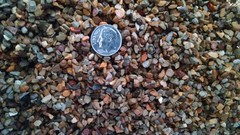
Subjective Hardness Test:
20% Hardness 1 (very soft)
55% Hardness 2
25% Hardness 3 (comparable to Turface)
Hardness 1 on Left, 2 middle, 3 right:
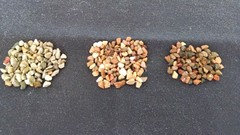
Runoff pH Test: 5.2 - 5.5
Screened Waste: Rather high, 55% or more.
CEC: Company Claims 27; Rep says has seen it as low as 5 or 6.
drew51 SE MI Z5b/6a
9 years agoFunny as both products are from the same company. Well they are mined at the same place! Low CEC means that our plants are getting the nutrients and not the mix, a good thing for me. Plus for me it is such a low percentage of my mixes. I'm not sure softness tells you how long it will last? Perlite is super soft crushes easily, yet seems not to break down that fast. The softness is more a reflection of how much air is in the granule. If clay held as much air as DE it might not be as hard. Clay with such a high CEC , makes one having to keep feeding the mix, and hope my plants get some.
I don't really make a gritty mix anymore, so maybe not the best product for that. Clay may be better, but the high CEC of clay means it pulls the negatively charged nutrients out of my fertilizer thus making them unavailable to my plant. As confirmed from this article from theAgronomic Library.
http://www.spectrumanalytic.com/support/library/ff/CEC_BpH_and_percent_sat.htm
Well CEC is good to know but as the article states...
..."The particular CEC of a soil is neither good nor bad, but knowing it is a valuable management tool. "....
Problem for me is DE or clay is not a major component so the overall CEC could be way different. A soil test would be in order.
For DE I like Optisorb as the particles are bigger.Related Professionals
Wixom Landscape Architects & Landscape Designers · Lakeland Landscape Contractors · Mooresville Landscape Contractors · East Chicago Landscape Contractors · Golden Gate Landscape Contractors · Hayden Landscape Contractors · Indio Landscape Contractors · Lantana Landscape Contractors · Long Branch Landscape Contractors · Pomona Landscape Contractors · Tinton Falls Landscape Contractors · Palos Heights Landscape Contractors · Wakefield Solar Energy Systems · Central Islip Window Contractors · Lincolnwood Fence Contractorslunarsolarpower
Original Author9 years agolast modified: 9 years agoNice hijack, drew. The topic here is evaluation of DE for use in gritty mixes. Which you say you don't use.
The durability issue of DE has been raised by others, repeatedly, and is a problem. I figured we could use a thread like this to put our heads together, test - and monitor - different companies' DE products to avoid root smothering sludge in our pots. It would also be nice to have reusable DE for our efforts, DE that holds up reasonably against granite, basalt, hard types of pumice, etc., during initial mixing, use, and recycling/reuse.
I figured while we're at it, also might as well test the pH, and since that issue is related to cec and nutrient uptake, might as well include that, as information from the companies themselves. Could be of use to someone in tailoring mixes, planning a fertigation regime, or evaluating deficiencies.
By the way, regarding your statement about fertilizer nutrient ion capture, you got it backwards. Cec sites attract cations. Positive charge.
The link is welcome. It nicely sums up what cec is, in the first paragraph, as a calculated estimate of a soil's ability to attract, retain, and exchange cation elements. Also, in the article, the two lines directly above the one you quoted note that, low cec soils "...may benefit from split applications of several nutrients." Good info there.
That level of analysis and management of my little windowsill pots is a bit more than I want to do. I appreciate the validation of my view, that a reasonable overall cec is a good thing in a gritty mix.
lunarsolarpower
Original Author9 years agolast modified: 9 years agoGreat link Nil13. Doesn't specifically mention calcined DE, but the article is examining the question of the relevance of cec numbers in soilless container media, for maintaining pH stability and nutrient availability - which is definitely germane to this discussion. Looks like part of a series, investigating how to better maintain crop health in production greenhouse settings.
It points to calcined clay as the one media that would provide useful buffering and nutrient delivery, even as a secondary component. They don't give any actionable info, however, citing the expense as prohibitive to their aims.
What I get out of it is, if DE is the major component of a mix, pH and nutrient levels of the fertigating solution have to be quite carefully controlled. Sounds a lot like hydroponics management.
andy_e
9 years agoI think drew had a good point though, about whether the hardness test you're doing is really measuring what you want to measure. I think what we're really interested in is durability of the particle over many wet/dry cycles. Soaking it for two days, and then crushing with your finger doesn't simulate that.
lunarsolarpower
Original Author9 years agolast modified: 9 years agoHi Andy,
I said that myself, in my test results, where I list concerns.
Got to start somewhere. So far, you all have pictures of what mushy DE looks like, Napa Floor Dry has a discredit mark on the ledger, Axis is shown to be promising, while on notice to step up its game, to protect its reputation - and we hopefully have the beginnings of a consumer product test of DE. Not a bad start, I think.
Do you have any ideas for testing?
Anyone testing other bags of Axis? Optisorb? Ultrasorb? Anyothersorb?
Nil13 usda:10a sunset:21 LA,CA (Mount Wash.)
9 years agolast modified: 9 years agoLunar, when you are using aggregate media you essentially have a 'to waste' hydroponics setup.
Drew also isn't really wrong about what CEC is doing. The media is taking the ions and pulling them out of solution thus making them unavailable to the plant. However, if you then water the plant with an acidic solution, the hydrogen ions will displace the nutrient ions thus making them available to the plant. So, that could mean less leaching and greater nutrient buffering since we typically apply more nutrients than the plant needs. But then again maybe not. One of the big problems with using native soil in containers dealt with anion exchange capacity. Native soils can have a lot of aluminum and/or clay which binds tightly with the anion, phosphate. Because of this, bloom boosters with lots of phosphate came into play in order to saturate the anion exchange sites and still provide nutrients to the plants. There is some work out there dealing with turface and phosphate preference that concludes that it is probably a good idea to soak turface in a superphosphate solution before use in order to charge it with phosphate. However, I have never seen a phosphorus deficiency when using Turface that had not been soaked in a Superphosphate solution.
lunarsolarpower
Original Author9 years agolast modified: 9 years agoYou may be reading Drew's statement as a description of leaching, to me, it reads as if the reference was to the clay locking the nutrients.
Regarding phosphate, isn't it anionic? Even in that article drew linked, it says phosphate doesn't hold to clay or organic matter, is highly reactive, and readily becomes insoluble. I thought the rationale for charging Turface with phosphate, was it would remain available, as it wouldn't bond to the negatively charged cec sites.
Look at me, all off topic. We should start a calcined clay thread for this.
Nil13 usda:10a sunset:21 LA,CA (Mount Wash.)
9 years agolast modified: 9 years agoI may have oversold the importance of anion exchange in the bonding of phosphate in soils to illustrate a point. Reaction with other elements like aluminum to form insoluble solids like aluminum phosphate are the major factor in locking up phosphate. The bit about clay not binding depends on the types of clay (kaolin clay not so much, silica clay yes). Phosphate won't bond to the ce sites but a medium can have both ce sites and ae sites. Just because an ion has bound to an exchange site doesn't mean it is never available. Another ion with preferential binding force can replace it thus dislodging the first previously unavailable ion. All I'm getting at is that if you have a lot of exchange sites, they have to be saturated before the ions will be available to the plant. If you are working with a medium that is devoid of ions in those sites and it has a fairly high bulk density, it may be a good idea to saturate those sites before using it. Of course more research is probably warranted as the research on low bulk density high CEC container media don't show any effect.
lunarsolarpower thanked Nil13 usda:10a sunset:21 LA,CA (Mount Wash.)lunarsolarpower
Original Author9 years agolast modified: 9 years agoThat makes sense. And I do get that ion bonding at exchange sites is just that, Exchangeable. Some here appear to believe those bonds are stronger than they are, or at least portray them as such, to further some viewpoint.
I think the other aspect here is, nutrient beyond ce and ae site saturation - nutrient that resides in the soil solution, not bonded to exchange sites. It's readily leachable, but that's actually where it's available to the roots.
Also, if I have it right, the roots still need organic acids available, to chelate the minerals for uptake.
Since gritty mixes are engineered to hold much of the "soil solution" inside the components, the internal volume of DE looks to me, like an advantage in continuous low dose feeding applications. Probably just have to ensure some organic acid in the fertigation regime.
I've never felt that low cec growing can't be managed. But if someone wants to actively adjust the cec in a fully inorganic setting, one tool could be a pH test of the DE runoff (before using it), to loosely guage what the cec is, for a given batch of calcined DE. I found what looks to be a practical relationship between cec and pH in DE and I think that can be exploited, with more data, which could come from folks testing their DE and posting the results here.
penfold2
9 years agoI've been using Floor Dry in my mix for 3.5 years now. I agree that it can be crushed fairly easily when wet, but it has proven to be very durable in soil. I've been repotting several plants that have been in that same mix the entire 3.5 years, and the soil looks just like it did the day I potted them. The only particles that have been broken down are a few that were trapped between thickening tuberous roots. Granite and Turface hold up to that crushing force, but Floor Dry does not.
As for CEC, I fertilize my plants at every watering, so it's of no concern to me.
-Chris
lunarsolarpower thanked penfold2lunarsolarpower
Original Author8 years agoHi Penfold,
That's important experience, something I hope I can learn from. 3.5 years is a long time. Do you recall if the Floor Dry batch you used looked like mine above, or more colorful, like the Axis? Do you recall the construction of the original mix? Were you able to rescreen the mix, and wash and reuse it? If you did, do you recall if you seemed to lose any more of the DE volume when you screened it? What plants did you have in it, and which ones seemed to cause the most loss? How long between repots?
Thanks!
Phil
penfold2
8 years agoMy Floor Dry has always been very white in color. There are no darker particles like in the Axis you posted. The mix I use is 4 parts granite, 3 parts Turface, and 3 parts Floor Dry. It looks like this:
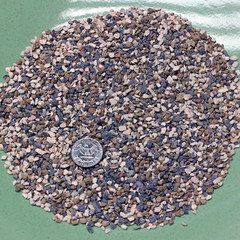
I don't reuse my mix, because of potential mineral accumulation within the Turface and Floor Dry. Otherwise, it would be perfectly reusable. The used mix looked just like the above photo, but with some broken roots mixed in. I saw no fine material or decrease in the proportion of Floor Dry. Just about all of my succulents are in this mix, but the ones I repotted recently were mostly succulent trees along with a couple Dorstenia and dwarf Aloe, and one Cyphostemma.Here's a photo of some of the roots capable of crushing Floor Dry, but this is just the occasional particle that gets trapped between them. The rest of the soil looks like above.
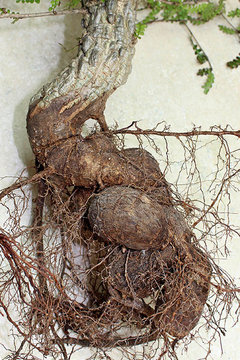
Hope this helps.-Chris
lunarsolarpower thanked penfold2lunarsolarpower
Original Author8 years agolast modified: 8 years agoThat helps a lot.
Thanks for the great photos. I see you've got red (dark purple looking) granite there, very nice. Is that the Manna Pro?
I am extremely interested in moving my succulents into fully inorganic mixes, if for no other reason than, I am not interested in trying to bare root my spiny little monsters, risking injury to both myself and my plants, unless absolutely necessary. I definitely want to avoid it with my euphorbia trigonas as they get older. I envision being able to do some root pruning as needed, while basically potting up.
Which brings me back to the motivation for this thread. Quite a few folks here seem to have had issues with floor dry products damaging their plants, when the stuff breaks down in the pots. Folks seem to have seen this issue with some bags, but not others, of the same product. That sort of thing bothers me. A lot. Because if I'm putting a lot of time and effort into this, I sure as heck don't want my precious plants screwed up over a defect in one of the growing media components.
The only way I know of to avoid this is to somehow test the component, in a way that lots of people can do, and to network that information.
Thanks for sharing.
-Phil
penfold2
8 years agoThe granite (actually quartzite according to the manufacturer) is called cherry stone. It's mined here in MN and only available in the midwest AFAIK.
I've had good results with my inorganic mix so far. I'm not sure about potting up without bare rooting. One of the nice things about this mix is that it's so easy to bare root plants with it. The mix is coarse enough and heavy enough that it tends to just fall away from the roots when unpotting. Repotting is also quite simple. I just hold the plant in place while pouring the soil into the roots. A few pokes with a chopstick ensure that all voids are filled, but even that is unnecessary in many cases since the soil is heavy enough to fill most voids on its own.
As for Floor Dry damaging plants, I've never heard of that. Are you sure you're not confusing it with Oil Dri, which is much more hit or miss? From what I've read, Floor Dry is one of the few products that holds up for everyone that uses it. You could also just use Turface instead. They serve the same purpose. The only reason I use both Turface and Floor Dry is for the additional color. I think 3 colors looks more aesthetically pleasing than 2.
-Chris
Nil13 usda:10a sunset:21 LA,CA (Mount Wash.)
8 years agoIf mineral accumulation is your concern Chris, why not just give the medium an overnight soak in some acidic water? That should take care of anything problematic. Just put the medium in a trashcan, fill it with water, and add some battery acid.
penfold2
8 years agoThat might work. It would at least take off the surface accumulation. I'm not sure about battery acid, but I have some citric acid that should be safe and effective. Maybe I'll try soaking some used soil and see what happens.
-Chris
lunarsolarpower
Original Author8 years agoBattery acid is sulfuric acid. Someone recommended that to me a few months back, too. His rationale made sense: Battery acid is pure, because contamination would be a huge liability; it converts calcium carbonate into gypsum, which doesn't raise pH; residual sulfur can make up for a lack of sulfur in a soilless mix.
I'm not convinced of the merits of that last point, but the first two seem right to me.
lunarsolarpower
Original Author8 years agolast modified: 8 years agoThe mushy DE complaints included Napa. The bag I have here sure confirmed it for me. Not only did it immediately smash with gentle pressure, it largely turned to mud when it was moist and worked - incorporated by hand mixing - into a mix with calcined clay and granite. A real mess.
I can't imagine the Napa lot I have remaining granular between repots.
Calcined clay (Turface) and calcined DE do differ in the water they hold, dry weight, cec effect in a container, effect on pH stability in a container. However, the point here isn't to advocate for or against either product, but to figure out which DE products are most stable for our horticultural purposes / experiments - and consistently so.








Nil13 usda:10a sunset:21 LA,CA (Mount Wash.)